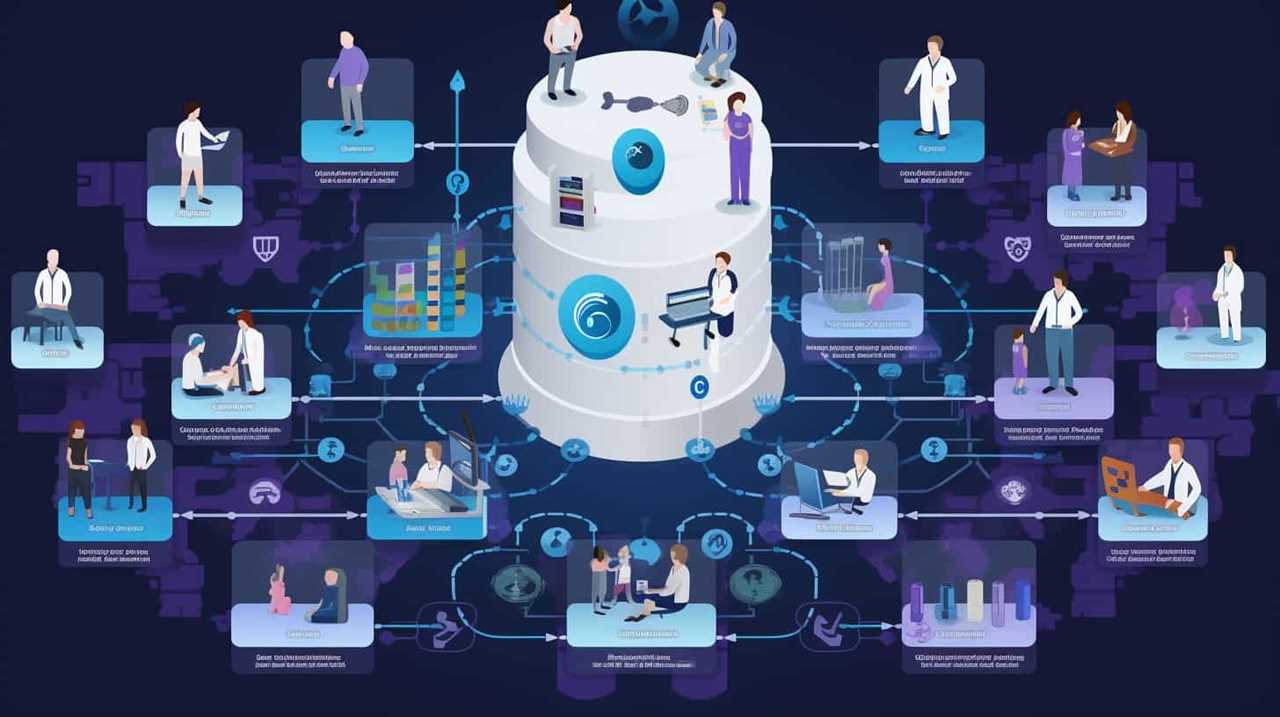Are you ready to maximize the full potential of your data?
In today’s fast-paced and ever-changing business landscape, leveraging AI for data-driven operational excellence has become the key to staying ahead of the curve.
Just like a skilled conductor leading a symphony, we can harness the power of AI to orchestrate a harmonious blend of data insights and operational strategies.
By combining the precision of AI algorithms with the expertise of our operational teams, we can uncover hidden patterns, optimize processes, and make informed decisions that drive exceptional performance.

In this guide, we will explore the strategies and best practices for leveraging AI to achieve operational excellence.
So, let’s dive in and unlock the symphony of success!
Key Takeaways
- AI enables organizations to leverage data-driven strategies and best practices.
- AI-powered analytics provide organizations with a comprehensive understanding of their operations.
- AI helps organizations streamline their operations and allocate resources more efficiently.
- AI plays a crucial role in automating tasks and reducing errors.
Understanding AI and Its Role in Operations
Understanding AI and its role in operations involves harnessing the power of advanced analytics to drive proactive decision-making and enhance overall operational excellence.
AI, or Artificial Intelligence, refers to the use of computer systems capable of performing tasks that typically require human intelligence. In the context of operations, AI enables organizations to leverage data-driven strategies and best practices to optimize their processes and achieve operational excellence.

By applying AI technologies, operations teams can gain valuable insights from vast amounts of data, enabling them to make informed decisions and identify patterns that may not be apparent through traditional methods. AI-powered analytics, such as descriptive, diagnostic, predictive, and prescriptive analytics, provide organizations with a comprehensive understanding of their operations, helping them identify areas for improvement and implement proactive strategies.
Moreover, AI plays a crucial role in automating tasks and reducing errors. By automating routine and repetitive processes, organizations can streamline their operations and allocate resources more efficiently. This not only improves productivity but also frees up valuable time for employees to focus on more strategic and value-added tasks.
Collecting and Analyzing Data for Operational Insights
We collect and analyze data for operational insights to drive informed decision-making and enhance overall operational excellence. Leveraging artificial intelligence (AI) and machine learning, organizations can improve the quality of their processes and customer satisfaction.
Here are five key points to consider when collecting and analyzing data for operational insights:

- Identify relevant data sources: Determine which data sources are crucial for gaining insights into your operations. This may include internal systems, customer feedback, and supplier data.
- Define metrics and KPIs: Establish clear metrics and key performance indicators (KPIs) that align with your organization’s goals. These metrics will help track progress and identify areas for improvement.
- Implement data analytics tools: Utilize data analytics tools to process and analyze large volumes of data efficiently. These tools can provide valuable insights and identify patterns that humans may overlook.
- Foster a culture of continuous improvement: Encourage employees to embrace data-driven decision-making and continuous improvement. This involves using data insights to identify opportunities for optimization and making data-backed decisions.
- Ensure data accuracy and security: Implement measures to ensure the accuracy and security of your data. This includes data validation processes, encryption techniques, and regular audits to maintain data integrity.
Implementing AI-powered Process Automation
When it comes to implementing AI-powered process automation, our focus is on enhancing efficiency and overcoming implementation challenges.
By leveraging AI technologies, we can streamline and automate repetitive tasks, allowing employees to focus on more value-added activities.
However, successful implementation requires addressing potential barriers such as data quality, integration issues, and resistance to change.
Enhancing Efficiency With AI
Implementing AI-powered process automation can significantly enhance operational efficiency. By leveraging AI technology, businesses can automate processes, reduce manual errors, and save time. Here are five ways AI can enhance efficiency:

- Streamline operations: AI-powered automation can optimize workflows, eliminating bottlenecks and reducing process cycle times.
- Improve data quality: AI algorithms can analyze and clean large volumes of data, ensuring accurate and reliable insights for decision-making.
- Enable advanced analytics: AI can process complex datasets and uncover hidden patterns, enabling businesses to make data-driven decisions and gain a competitive edge.
- Enhance customer experiences: AI-powered chatbots can provide personalized and seamless interactions, reducing customer wait times and improving satisfaction.
- Increase productivity: AI automation can handle repetitive tasks, freeing up employees to focus on more strategic and value-added activities.
Implementing AI for operational excellence does come with challenges, which we’ll discuss in the next section.
Overcoming Implementation Challenges
To overcome the challenges of implementing AI-powered process automation, an organization must carefully address data security and privacy concerns. Clear communication and training can help employees understand the benefits of AI-powered automation, reducing resistance to change. Integration and compatibility issues may arise, but careful planning and coordination are required to ensure seamless implementation.
As organizations strive towards operational excellence, leveraging AI algorithms to identify areas that require optimization is crucial. By enabling real-time data analysis and decision-making, AI-powered automation saves time, reduces costs, and increases efficiency. Identifying potential areas for improvement and leveraging AI as a powerful tool in the decision-making process are crucial components in achieving operational excellence.
Addressing these implementation challenges sets the stage for enhancing decision-making with AI-driven analytics.

Enhancing Decision-Making With Ai-Driven Analytics
We can enhance decision-making by leveraging AI-driven analytics. AI technologies provide us with powerful tools to analyze data, gain valuable insights, and make informed decisions for operational excellence. Here are five ways AI-driven analytics can enhance decision-making:
- Predictive analytics: AI algorithms can analyze historical data and identify patterns and trends to forecast future events. This enables us to make proactive decisions and take preventive actions to avoid potential issues.
- Prescriptive analytics: AI can suggest actions based on data analysis to optimize performance and achieve operational excellence. By automating decision-making processes, we can reduce errors and improve efficiency.
- Real-time data analysis: AI-driven analytics can process vast amounts of data in real-time, providing us with up-to-date information for decision-making. This allows us to respond quickly to changing situations and make agile decisions.
- Customer satisfaction improvement: AI initiatives can analyze customer data to understand preferences, behavior, and sentiment. This helps us tailor our products and services to meet customer needs and improve satisfaction levels.
- Data-driven decision-making: AI-driven analytics enable us to make decisions based on objective data rather than intuition or guesswork. By utilizing AI technologies, we can make more accurate and informed decisions, leading to better outcomes and operational excellence.
Overcoming Challenges in AI Implementation
To successfully navigate the implementation of AI, it is crucial that we address and overcome the challenges that arise. The adoption of AI and automation in organizations is a strategic move towards achieving operational excellence and improving decision-making through data-driven insights. However, several challenges can hinder the smooth implementation of AI in organizations.
One of the common challenges faced during AI implementation is resistance to change. Employees may be hesitant to embrace AI due to fear of job displacement or lack of understanding about its benefits. Clear communication and training programs can help address these concerns and educate employees about the positive impact of AI on their work. Another challenge is the integration and compatibility issues that may arise when implementing AI systems. Careful planning and coordination are necessary to ensure that AI systems seamlessly integrate with existing technologies and processes.
The table below highlights the key challenges in AI implementation and provides strategies and best practices to overcome them:

| Challenges | Strategies and Best Practices |
|---|---|
| Resistance to change | Communicate the benefits of AI, provide training and support, involve employees in the decision-making process |
| Integration and compatibility issues | Conduct a thorough analysis of existing systems, ensure compatibility with legacy technologies, plan for seamless integration |
| Data security and privacy concerns | Implement robust security measures, comply with data protection regulations, conduct regular audits and risk assessments |
By addressing these challenges and implementing the recommended strategies and best practices, organizations can successfully leverage AI to improve operational excellence and decision-making. However, it is important to also ensure data security and privacy in AI-powered operations, which will be discussed in the next section.
Ensuring Data Security and Privacy in AI-powered Operations
When it comes to AI-powered operations, ensuring ethical practices and complying with data protection regulations are crucial elements in maintaining data security and privacy.
By adhering to ethical AI practices, organizations can ensure that data is being used in a responsible and transparent manner, addressing concerns related to bias and discrimination.
Additionally, data protection regulations provide a framework for safeguarding sensitive information, giving individuals the assurance that their personal data is being handled appropriately.

Ethical AI Practices
As we strive for data-driven operational excellence, it’s imperative to prioritize ethical AI practices by ensuring data security and privacy in AI-powered operations. To achieve this, we must implement the following strategies and best practices:
- Collaboration: Foster collaboration between AI teams, data scientists, and security professionals to address privacy concerns and ensure data security.
- Compliance with relevant regulations: Stay up-to-date with the latest regulations and standards related to data security and privacy to ensure compliance.
- Data anonymization: Implement techniques such as data anonymization to protect sensitive information and mitigate privacy risks.
- Regular security audits: Conduct regular security audits to identify vulnerabilities and ensure the integrity and confidentiality of data in AI systems.
- Transparent data usage policies: Establish transparent data usage policies and communicate them to stakeholders to build trust and maintain privacy.
Data Protection Regulations
Our collaboration with AI teams, data scientists, and security professionals ensures that we comply with data protection regulations, ensuring data security and privacy in our AI-powered operations. Data-driven operational excellence relies on leveraging AI to drive better outcomes, but organizations must also prioritize data security and privacy. To ensure compliance with data protection regulations, organizations can implement the following strategies and best practices:
| Strategies | Best Practices |
|---|---|
| Implement data privacy policies and procedures | Regularly update and communicate privacy policies to all stakeholders |
| Promote data quality, quantity, diversity, and privacy | Establish data governance frameworks and processes to ensure data quality and diversity |
| Implement data cleaning and validation processes | Regularly conduct data audits and validation checks to identify and correct errors |
| Train employees on data security and privacy | Conduct regular training sessions to educate employees on data protection regulations and best practices |
| Monitor and assess data security measures | Implement robust monitoring systems to detect and address any potential security breaches |
Best Practices for Successful AI Integration
To achieve successful AI integration, we must prioritize identifying and addressing potential challenges. Implementing AI into our operational processes requires careful planning and execution. Here are some best practices to ensure a smooth integration:
- Collaboration: Foster cross-functional collaboration between IT, data scientists, and business teams to ensure alignment and shared understanding of goals and objectives.
- Analyze data: Conduct a thorough analysis of existing data to identify patterns, trends, and insights that can inform the AI integration strategy. This will help in determining the areas where AI can have the most significant impact.
- Address issues: Identify and address any potential issues or limitations that may arise during the AI integration process. This includes data quality, security concerns, and ethical considerations.
- Make data-driven decisions: Use AI-powered analytics to make data-driven decisions. Leverage the power of AI algorithms to analyze vast amounts of data and extract valuable insights, enabling you to optimize operational processes and drive operational excellence.
- Continuously optimize: Regularly monitor and evaluate the performance of AI systems to identify areas for improvement. This includes refining algorithms, addressing biases, and adapting to changing business needs.
Future Trends in AI for Operational Excellence
One emerging trend in AI for operational excellence is the increasing use of machine learning algorithms to automate and optimize business processes. As organizations strive for operational excellence, they’re leveraging AI and automation to drive efficiency, reduce costs, and improve overall performance. Machine learning algorithms have the ability to analyze large volumes of data, identify patterns, and make accurate predictions, enabling organizations to make data-driven decisions and take proactive measures to prevent negative outcomes. By automating repetitive tasks and streamlining workflows, machine learning algorithms not only save time and resources but also enhance the accuracy and consistency of business processes.

Another future trend in AI for operational excellence is the integration of AI-powered chatbots and virtual assistants. These intelligent virtual agents are capable of understanding and responding to natural language queries, providing real-time support and assistance to customers and employees. By leveraging AI, organizations can enhance customer satisfaction, improve response times, and reduce the workload on human agents.
Furthermore, AI is also being used to improve supply chain management and logistics. By analyzing historical data, AI algorithms can identify patterns and predict demand, enabling organizations to optimize inventory levels and reduce stockouts. AI can also optimize delivery routes and schedules, improving efficiency and reducing transportation costs.
Frequently Asked Questions
How Is AI Used in Operational Excellence?
In operational excellence, AI plays a crucial role by utilizing predictive and prescriptive analytics to prevent quality problems and enhance proactive strategies.
It improves supplier quality by monitoring metrics, using supplier data for informed decisions, and collaborating with low-performing suppliers to enhance quality.

AI measures effectiveness by tracking defects and safety incidents, adding assessments to employee training modules, and using risk management tools for a high-level view of risk data.
It optimizes operations, improves customer satisfaction, and drives growth through increased efficiency and productivity.
What Is an Example of an Operational Excellence Best Practices in Operate?
An example of an operational excellence best practice in operate is implementing leading indicators to prevent quality problems.
By analyzing historical data and adjusting audit frequency, we can proactively identify and address potential issues before they occur.

This proactive approach allows us to reduce the number of defects and improve overall product quality.
What Are Operational Excellence Strategies?
Operational excellence strategies are a key component of achieving success in today’s dynamic business environment. By focusing on streamlining processes, eliminating waste, and continuously improving productivity, organizations can stay ahead of the competition.
Leveraging data and AI technologies allows us to identify leading indicators, such as audit frequency and training assessment scores, that help drive proactive strategies.
Additionally, managing suppliers, benchmarking, and collaborating to enhance quality are essential for improving supplier performance.

Measuring effectiveness through recurrence of defects, safety incidents, and using Enterprise Risk Management tools is crucial for ensuring operational excellence.
What Are the 3 Components of Operational Excellence?
Operational excellence comprises three key components that drive success: efficient processes, waste elimination, and continuous improvement.
By focusing on these pillars, we can optimize productivity and achieve excellence in our operations.
Efficient processes ensure smooth workflows and effective resource utilization.

Waste elimination targets unnecessary steps, materials, and time, maximizing efficiency.
Continuous improvement involves constantly analyzing data and seeking opportunities for enhancement.
Together, these components form the foundation for operational excellence, enabling organizations to thrive in today’s competitive landscape.
Conclusion
In conclusion, leveraging AI for data-driven operational excellence is crucial for businesses to stay competitive in today’s rapidly evolving landscape.

By defining clear objectives, collecting and analyzing relevant data, and implementing AI-powered automation and analytics, organizations can unlock valuable insights and drive continuous improvement.
It’s essential to foster a culture of data-driven decision-making and adapt AI models to changing business needs.
With these best practices, businesses can achieve remarkable operational excellence and propel themselves towards future success.









